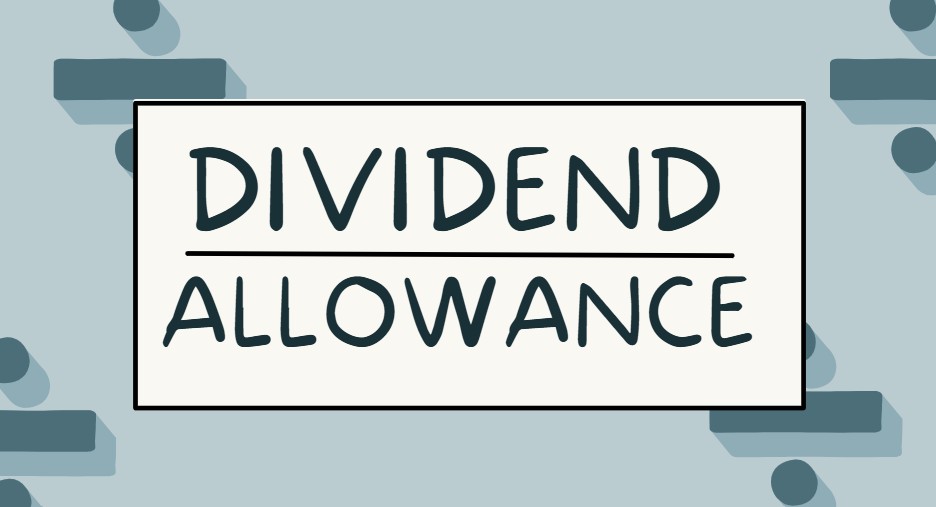Table of Contents
ToggleThe UK government has been making continuous changes to dividend taxation, impacting investors, business owners, and self-employed individuals. For the 2024/25 tax year, the dividend allowance has been reduced significantly, leaving many taxpayers with higher tax liabilities on their investment income.
If you receive dividend payments from company shares, it is essential to understand how these changes affect you, what the new tax rates are, and how you can minimise your tax liability legally.
This guide covers everything you need to know, from dividend tax bands and payment deadlines to tax-efficient strategies for reducing your overall tax burden.
What Is the Dividend Allowance in 2024/25?

The dividend allowance is the threshold of dividend income you can receive before you must start paying tax. The allowance applies regardless of your total earnings, meaning both low-income and high-income taxpayers can benefit.
For the 2024/25 tax year, the dividend allowance has been slashed to £500, a significant reduction from previous years:
| Tax Year | Dividend Allowance |
| 2022/23 | £2,000 |
| 2023/24 | £1,000 |
| 2024/25 | £500 |
This means that any dividend income exceeding £500 will now be subject to tax, based on the individual’s income tax bracket.
However, dividend income earned through ISAs (Individual Savings Accounts) remains completely tax-free, making ISAs a popular investment tool for those looking to avoid dividend taxation.
What Are the Dividend Tax Rates for 2024/25?
The amount of tax you pay on dividends depends on your total taxable income, which includes all earnings such as salary, rental income, and self-employment profits. Once your total earnings exceed the £12,570 personal allowance, dividend income is taxed as follows:
England, Wales & Northern Ireland Dividend Tax Rates
| Income Tax Band | Taxable Income | Dividend Tax Rate |
| Basic Rate | £12,571 – £50,270 | 8.75% |
| Higher Rate | £50,271 – £125,140 | 33.75% |
| Additional Rate | Over £125,140 | 39.35% |
Scottish Dividend Tax Rates
Scotland has different income tax bands for earnings, but dividend income is still taxed under UK-wide rules:
| Scottish Tax Band | Taxable Income | Dividend Tax Rate |
| Starter Rate | £12,571 – £14,876 | 8.75% |
| Basic Rate | £14,877 – £26,561 | 8.75% |
| Intermediate Rate | £26,562 – £43,662 | 8.75% |
| Higher Rate | £50,271 – £75,000 | 33.75% |
| Advanced Rate | £75,001 – £125,140 | 33.75% |
| Top Rate | Over £125,140 | 39.35% |
If dividends are your only source of income, you can receive up to £13,070 tax-free by combining the £12,570 personal allowance and the £500 dividend allowance.
How Much Tax Will You Pay on Dividends?

The amount of dividend tax you owe depends on how much you earn in total, including dividends and any other income, such as salary, rental income, or self-employment profits. Dividend income is only taxed once your total taxable earnings exceed the dividend allowance (£500 for 2024/25).
If your total earnings remain within the personal allowance of £12,570, you may not have to pay any tax on dividends. However, for earnings above this threshold, dividend income will be taxed based on the income tax band you fall into.
Example Scenarios for Dividend Tax Calculation
To illustrate how much tax you may need to pay, let’s consider a few different scenarios:
Scenario 1: Only Dividend Income (£10,000 in Dividends)
A person whose only source of income is £10,000 in dividends will pay no tax.
- £500 is covered by the dividend allowance.
- The remaining £9,500 falls within the £12,570 personal allowance.
- Since the total income is below the taxable threshold, no dividend tax is owed.
Scenario 2: Basic Rate Taxpayer (£25,000 in Dividends, No Salary)
If someone earns £25,000 in dividends with no other income, they will have to pay some tax:
- £500 is tax-free under the dividend allowance.
- £12,570 is tax-free under the personal allowance.
- The remaining £11,930 is taxed at 8.75% (basic rate) = £1,044 tax owed.
- Final take-home income: £23,956 after tax.
Scenario 3: Higher Rate Taxpayer (£15,000 in Dividends + £40,000 Salary)
If a taxpayer earns a £40,000 salary and £15,000 in dividends, their total earnings are £55,000, placing them in the higher-rate tax bracket.
- £500 dividend allowance applies.
- £12,570 salary is covered by the personal allowance.
- The remaining £9,770 in dividends is taxed at 8.75% (basic rate) = £855.
- The next £4,730 in dividends is taxed at 33.75% (higher rate) = £1,596.
- Total dividend tax owed: £2,451.
These examples highlight how dividend tax liability increases based on total income and tax bands. To quickly work out your liability, you can use our dividend tax calculator to estimate how much tax you’ll need to pay based on your total income.
How to Minimise Your Dividend Tax Liability?

Even with the lower dividend allowance, there are several legal ways to reduce the amount of tax you pay on dividends. Proper tax planning can help protect your investment income and increase your take-home earnings.
1. Use ISAs for Tax-Free Dividends
Investing in Stocks and Shares ISAs allows you to earn dividends completely tax-free. The annual ISA allowance for 2024/25 is £20,000, meaning you can invest up to this amount without worrying about dividend tax.
2. Transfer Shares to a Spouse or Partner
If your spouse or civil partner is in a lower tax bracket, you can transfer shares to them. This strategy helps reduce the household’s overall tax burden. For example, if one partner is a higher-rate taxpayer, but the other is in the basic rate bracket, transferring shares can ensure dividends are taxed at the lower rate of 8.75% instead of 33.75%.
3. Make Pension Contributions
Contributing to a pension reduces your taxable income, which can help keep your total earnings below higher tax thresholds. Pension contributions also qualify for tax relief, making them a highly effective way to reduce overall tax liability.
4. Balance Salary and Dividends for Business Owners
Limited company directors often pay themselves through a combination of salary and dividends to minimise tax. Keeping salary within the personal allowance (£12,570) and taking dividends up to the basic rate threshold can reduce overall tax exposure. However, this strategy should be reviewed annually based on government policy changes.
How to Report and Pay Dividend Tax?
If your dividend income exceeds the £500 allowance, you must report and pay tax to HMRC. The process for reporting dividends depends on how much you earn.

Dividend Income Below £10,000
If your dividend income is less than £10,000, you can report it through:
- Self-Assessment tax return, if you already file one.
- Contacting HMRC and asking them to update your tax code, so the tax is deducted from your wages or pension.
Dividend Income Over £10,000
If your dividend income exceeds £10,000, you must register for Self-Assessment and file a tax return. The key deadlines for reporting and paying dividend tax are:
- 5 October 2025: Deadline to register for Self-Assessment if you haven’t done so before.
- 31 January 2026: Deadline to file your tax return and pay your dividend tax for the 2024/25 tax year.
Failing to file a Self-Assessment tax return on time can result in penalties and interest charges, so it’s important to report dividends accurately.
Will There Be More Changes to Dividend Allowance in the Future?
Over the past few years, the UK government has progressively reduced the dividend allowance from £5,000 in 2016 to just £500 in 2024/25. Given this trend, many financial experts believe that the allowance could be removed entirely, meaning all dividend income would be taxable in future tax years.
The government’s reasoning behind these changes is to increase tax revenue and ensure fairness between self-employed business owners, investors, and salaried workers. However, further reductions or policy changes could increase the tax burden on small business owners and individual investors.
While there are no official plans to remove the dividend allowance entirely, it is crucial for taxpayers to stay updated on potential tax reforms. Keeping an eye on budget announcements and consulting a tax professional can help individuals adapt their tax strategy accordingly.
What Happens If You Exceed Your Dividend Allowance?
If your dividend income exceeds the £500 allowance, the additional amount will be taxed based on your income tax band. The tax rate you pay depends on your total taxable income, including salary, rental income, and self-employment earnings.
For instance, if you receive £2,500 in dividends, the first £500 is tax-free, while the remaining £2,000 is taxable. If you are a basic rate taxpayer, you will pay 8.75% tax on this amount (£175 tax owed). Higher and additional rate taxpayers will pay 33.75% or 39.35% tax on dividends exceeding their allowance.
It is important to set aside money for tax payments to avoid financial strain when settling your Self-Assessment tax bill. Keeping records of dividends received, tax deductions, and other income will make it easier to calculate your liability and report it accurately to HMRC.
How Can Business Owners Reduce Dividend Tax?

Business owners, particularly limited company directors, often rely on dividends as part of their income strategy. However, with the dividend allowance reduction, they may face higher tax bills. There are several ways to legally reduce dividend tax while remaining compliant with HMRC regulations.
One common strategy is to balance salary and dividends. Since dividends are not subject to National Insurance contributions (NICs), many company directors pay themselves a low salary (within the personal allowance) and take the remainder as dividends. However, the new dividend tax rules require careful planning to avoid higher-rate tax bands.
Another effective method is income splitting, where business owners transfer shares to a spouse or civil partner who falls into a lower tax bracket. This can reduce the household’s overall tax burden and make better use of personal allowances.
Additionally, making pension contributions can lower taxable income, potentially keeping dividend earnings within the basic rate tax band. Since pension contributions qualify for tax relief, they provide a dual benefit of reducing tax and saving for retirement.
Business owners should consult a tax specialist or accountant to develop a tax-efficient withdrawal strategy that aligns with their income needs and company profits while minimising tax exposure.
Conclusion
The dividend allowance reduction in 2024/25 means that more UK taxpayers will pay tax on dividends than ever before. Understanding how dividend tax works, reporting your dividends correctly, and implementing tax-efficient strategies can help you minimise tax liability.
For those who regularly earn dividend income, considering ISAs, pension contributions, and tax planning strategies is essential. Additionally, ensuring timely tax reporting can prevent penalties and compliance issues with HMRC.
For personalised tax advice, it’s always best to consult a tax advisor or financial expert to ensure you are making the most of available tax-saving opportunities.
Frequently Asked Questions About Dividend Allowance 2024/2025
How much dividend income is tax-free in 2024/25?
The tax-free dividend allowance for 2024/25 is £500. Any dividends above this amount are taxed based on your income tax band.
How much dividend can I pay myself tax-free in 2024?
If dividends are your only income, you can receive up to £13,070 tax-free by combining the £12,570 personal allowance and the £500 dividend allowance.
How much tax will I pay on my dividends?
The tax you pay depends on your income tax band. For example, if you receive £2,500 in dividends, the first £500 is tax-free, and the remaining £2,000 is taxed at your applicable rate (8.75%, 33.75%, or 39.35%).
How much dividends are tax-free?
For 2024/25, only £500 of dividend income is tax-free under the dividend allowance. Any amount above this is taxed according to your income tax band.
What is the maximum dividend a company can pay?
A company can only pay dividends from its available profits after corporation tax. There is no fixed maximum, but dividends must be backed by retained earnings.
Do I need to do a tax return if I get dividends?
If your dividends exceed £500, you need to report them to HMRC. If you receive over £10,000 in dividends, you must file a Self-Assessment tax return.
When is the deadline to pay dividend tax?
For dividends received in 2024/25, the Self-Assessment tax return deadline is 31 January 2026. If you haven’t registered for Self-Assessment before, the deadline is 5 October 2025.
Will the dividend allowance change again in the future?
While no official changes have been announced, the government has steadily reduced the allowance in recent years. Further changes are possible, so it’s important to stay updated.




